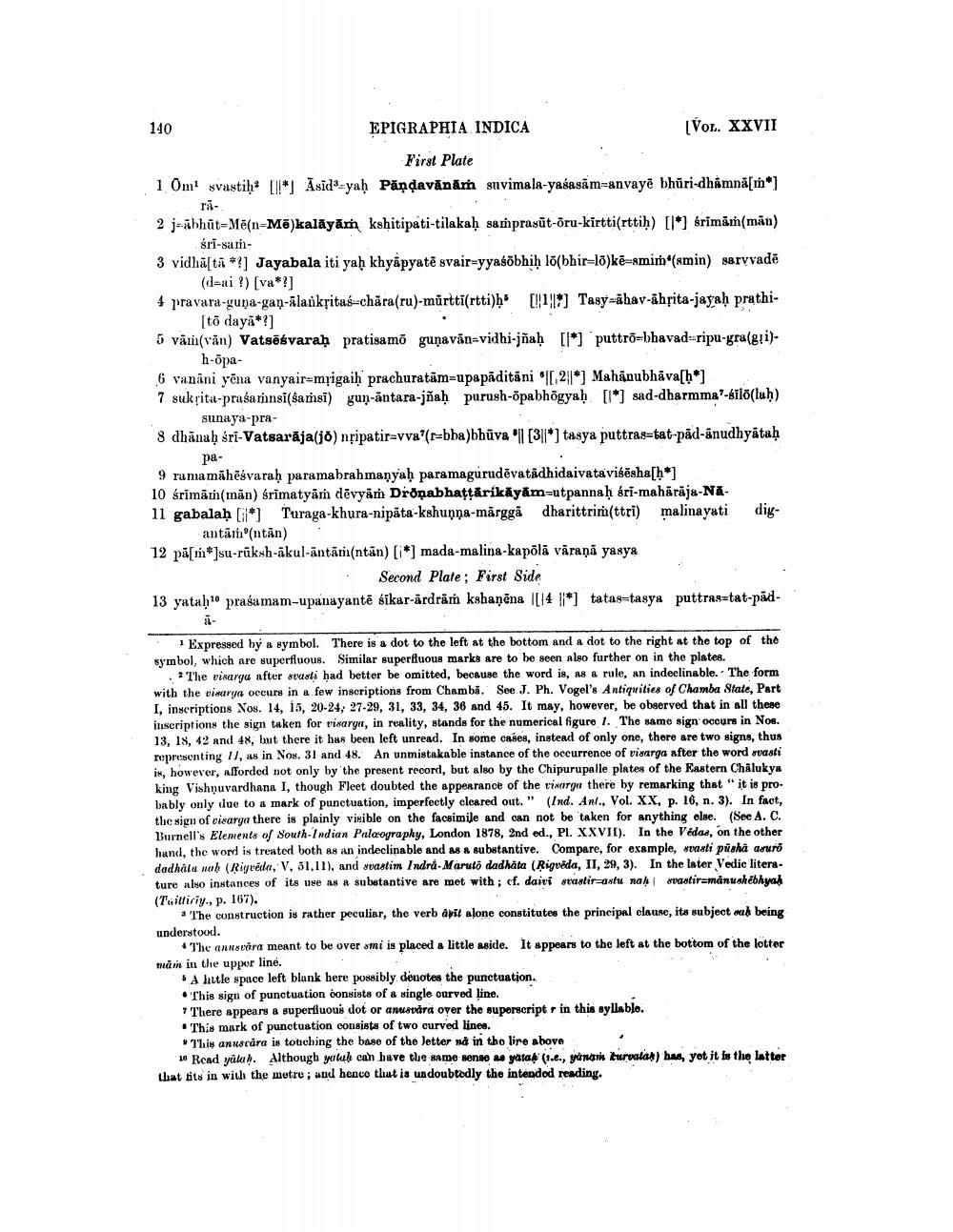________________
140 EPIGRAPHIA INDICA
(VOL. XXVII First Plate 1 Om svastiha [*] Asid -yaḥ Pāņdavānāṁ suvimala-yaśasām=anvayê bhūri-dhámnä[m*]
ra2 jābhūt=Mē(n=M7)kalāyām kshitipati-tilakaḥ samprasūt-oru-kirtti(rttih) [I*] Srimām(man)
sri-sam3 vidhästa *?] Jayabala iti yaḥ khyāpyatē svair=yyasõbhiḥ lõ(bhir=17)kē=smim"smin) sarvvadē
(d=ai ?) [va*?] 4 pravara-guna-gan-ālauksitas-chāra(ru)-mūrtti(rtti)h' [!!1!18) Tasy-ābav-ährita-jayaḥ prathi
[to dayā*?] 5 vā(vān) Vatsēsvaraḥ pratisamo guņavān=vidhi-jñaḥ [l*) puttro-bhavadaripu-gra(gļi)
h-opa6 vanāni yēna vanyair=mțigaih prachuratām=upapāditāni "10211*] Mahanubhāva[h*] 7 sukrita-prasariisi(Sarnsi) gun-antara-jñaḥ purush-opabhögyah [1] sad-dharmma'-silö(luh)
sunaya-pra8 dhānaḥ śri-Vatsarāja(jo) nļipatir=vva?(r-bha)bhūva 'll [3||*) tasya puttrastat-păd-ānudhyatah
pa9 ramamahēsvarah paramabrahmanyaḥ para magurudevatadhidaivatavisësha[h*] 10 srimămmän) srimatyām dēvyám Drönabhattărikäyäm=utpannah Sri-mahäräja-Nă. 11 gabalah (*) Turaga-khura-nipăta-kshuņņa-märggă dharittrim(ttri) malinayati diy
antām(ntān) 12 pä[m*]su-rūksh-akul-antām(ntân) [i*] mada-malina-kapõlā vāraņā yasya
. Second Plate; First Side 13 yatabo pragamam-upanayantë sikar-ardrām kshaņēna [14 18*tatas-tasya puttras-tat-pad
Expressed by a symbol. There is a dot to the left at the bottom and a dot to the right at the top of tho symbol, which are superfluous. Similar superfluous marks are to be seen also further on in the plates.
.The visarga after susti had better be omitted, because the word is, as a rule, an indeclinable. The form with the vixarya occurs in a few inscriptions from Chamba. See J. Ph. Vogel's Antiquities of Chamba State, Part I, inscriptions Nos. 14, 15, 20-24; 27-29, 31, 33, 34, 36 and 45. It may, however, be observed that in all these inscriptions the sign taken for visargi, in reality, stands for the numerical figure 1. The same sign occurs in Nos. 13, 18, 42 and 4x, but there it has been left unread. In some cases, instead of only one, there are two signs, thus representing 1, as in Nos. 31 and 48. An unmistakable instance of the occurrence of visarga after the word svasti is, however, afforded not only by the present record, but also by the Chipurupalle plates of the Eastern Chalukya king Vishnuvardhana I, though Fleet doubted the appearance of the risarga there by remarking that "it is probably only due to a mark of punctuation, imperfectly cleared out." (Ind. Ant., Vol. XX, p. 16, n. 3). In fact, the sign of cisarga there is plainly visible on the facsimile and can not be taken for anything else. (See A. C. Burnell's Elements of South Indian Paleography, London 1878, 2nd ed., Pl. XXVII). In the Vedas, on the other hand, the word is treated both as an indeclinable and as a substantive. Compare, for example, rasti pisha asuri dadhalu nah (Rigveda, V, 51,11), and svastim Indra-Maruto dadhata (Rigveda, II, 29, 3). In the later Vedic literature also instances of its use as a substantive are met with; cf. daivi svastiraxtu nahi wastir=manushēbhyak (Taittiriy., p. 167).
* The construction is rather peculiar, the verb ávit alone constitutes the principal clause, its subject out being understood.
* The annsvāra meant to be over smi is placed a little aside. It appears to the left at the bottom of the lotter main in the upper line.
A little space left blank here possibly denotes the punctuation. • This sign of punctuation consists of a single ourved line. ? There appears a superfluous dot or anusvåra over the superscript r in this syllablo. . This mark of punctuation consists of two curved lines.
This anuscára is touching the base of the letter nå in tho lire shove 10 Read yūlah. Although yutih can have the same sense w yatak (1.2., yanan burvalak) has, yet it is the latter that fits in with the metre; and hence that is undoubtedly the intended reading.




